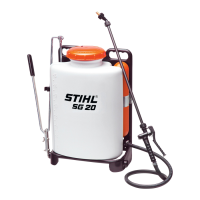SG 20
English
6
During Operation
Holding and Controlling the
Backpack Sprayer
The backpack sprayer is operated with
the right hand on the trigger valve and
the left hand on the hand lever.
The backpack sprayer is carried as a
backpack.
In order to keep the container upright
and reduce the risk of spillage, do not
bend at the waist. Bend only at the
knees and support yourself as required
to ensure proper balance.
Remember that a sprayer filled with
liquid has a significant amount of weight.
Use caution when bending, leaning or
walking.
Working Conditions
Operate your backpack sprayer only in a
well-ventilated area. Operate it under
good visibility and daylight conditions
only. Work carefully.
Operating instructions
Keep children and pets away from areas
that have just been sprayed. After the
use of some chemicals, especially
agricultural pesticides, a notice must be
posted on the treated area that a
"Restricted Entry Interval" (REI) is in
effect. See the product’s label and any
applicable governmental regulations.
Never spray in the direction of humans,
animals or property which might be
injured or damaged by spray formula.
Warning!
Adjust carrying harness to suit your size
before starting work.
Warning!
To reduce the risk of injury from loss of
control, never work on a ladder, in a tree
or on any other insecure support.
Warning!
Inhalation of certain chemicals can
cause susceptible persons to have an
allergic or asthmatic reaction. Substan-
tial or repeated inhalation of certain
chemicals may cause respiratory dis-
ease, cancer, birth defects, or other
reproductive harm. Control the chemical
spray at the source where possible. Use
good work practices, such as operating
the unit so that the wind or operating
process does not blow the spray back
on the operator. Follow the recommen-
dations of EPA/OSHA/NIOSH and
occupational and trade associations
with respect to proper usage. When the
inhalation of the chemical being sprayed
cannot be avoided, the operator and
any bystanders may need to wear a res-
pirator approved by NIOSH/MSHA for
the type of chemical encountered. Con-
sult the label of the chemical product
being used.
Warning!
If you are unfamiliar with the risks asso-
ciated with the particular chemical at
issue, review the product label and/or
material safety data sheet for that sub-
stance and/or consult the material
manufacturer/supplier. You may also
consult your employer, governmental
agencies such as the EPA, OSHA and
NIOSH and other sources on hazardous
materials. The state of California and
some other authorities, for instance,
have published lists of substances
known to cause cancer, reproductive
toxicity, etc.
Warning!
Pay attention to the direction of the
wind, i.e., do not work against the wind.
When spraying, stand so that the wind
does not blow towards you or
bystanders.

